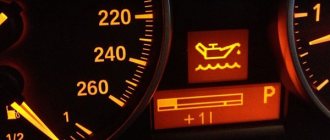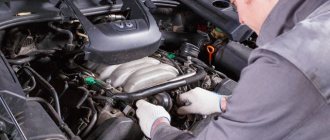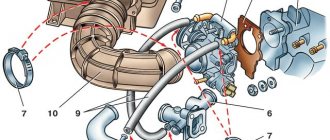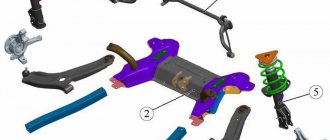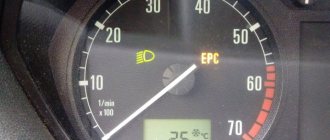April 10, 2017 Lada.Online 185 291 9
Currently, all LADA models (Lada XRAY, Vesta, Largus, Granta, Kalina, Priora, Niva 4×4) without exception are equipped with ABS (anti-lock braking system). During the operation of the car, many owners notice that the ABS and ESC lamps (if this system is available) light up on the instrument panel. Let's figure out how to solve this problem and improve the design.
Working principle of ABS
The anti-lock braking system is installed on the car as additional equipment, the task of which is to prevent the wheels from locking during heavy braking. Thanks to ABS, when you press the brake pedal hard, the car will not skid either on dry asphalt or on a wet road.
And yet, what is abs in a car? This system is a complex electronic device that includes a central unit and speed sensors installed on each wheel. When you apply the brakes, they determine the speed at which each wheel rotates. Then clever electronics remove excess pressure from the brake line into a special hydraulic accumulator.
At the same time, the rotation of the wheel begins to be restored, as the brake pads are released. If the pressure is still high enough, the process described above is repeated again until it returns to normal.
When to change the CV joint, signs of malfunction
As was said, the external grenade fails after about 40 thousand mileage. This is evidenced by crunching, creaking and knocking sounds in the area of the drive shafts. To determine which side of the CV joint requires replacement, you need to turn the steering wheel all the way and drive off. In 90% of cases, a worn drive will manifest itself as a crunching sound. For control, you can turn it first in one direction, and then in the other direction, and turn it back. If the CV joint is worn out, a crunching sound will be heard immediately.
This is the case when there are no visual signs of wear:
- Lubricant leaks near the outer joint.
- Cracks, tears on the boot.
- Lost or misaligned clamps.
- There is obvious play when turning the suspended wheel.
If there are visual signs of wear, we replace the CV joint on the Grant as soon as possible.
Purpose of ABS
The anti-lock braking system, based on its operating principle, imitates the actions of an experienced motorist who uses intermittent braking on a slippery road to prevent the car from skidding. And here the question arises: why do we need an electronic system when the driver himself can perform these actions? Cars that do not have ABS installed are quite difficult to control during heavy braking, and in many situations it is simply impossible to manage without it.
Note! The anti-lock braking system is automatically activated 15-20 times per second, resulting in minimal braking distance in the event of emergency braking. A person is physically unable to work at such a speed.
Perhaps the main advantage of ABS is that the driver, even under heavy braking, can make the car obey the steering wheel. When this device is absent, during the braking process the car will slide uncontrollably along a straight path, despite all the efforts of the driver to level the movement of the personal vehicle by turning the steering wheel.
When ABS , you can hear a soft cracking sound in the cabin, indicating the functioning of the executive unit, and feel gentle and frequent pushes on the brake pedal. Those motorists who have not previously dealt with such a system will need some time to get used to this innovation.
The car's anti-lock braking system has proven itself to be excellent, but, nevertheless, there were a number of dissatisfied motorists who claim that no electronics can replace an experienced driver, because he is much better able to navigate a difficult situation on the road and take the right actions.
Note! ABS does not interfere with the braking process at all, but serves as an indispensable assistant in preventing an irreparable traffic situation. Thanks to the anti-lock braking system, the uncontrollable mountain of iron into which the car turns during heavy braking begins to obey the steering wheel and is capable of performing at least some maneuvers.
Video about ABS
The principle of operation of the ABS system is clearly shown in this video:
We will try to figure out what ABS is in a car in the next 5 minutes while you read our article. It would seem to be a shame for a modern motorist not to know such a concept, but our task is precisely to explain what is awkward to ask about in our own environment. The new-fangled expression “anti-lock braking system” is synonymous with a modern braking device that allows you to maneuver with the brake pedal pressed. What's the gain?
ABS system in a car - to be or not to be?
Let's look at how the ABS system works in a car when the brake pedal is pressed, and compare it with a conventional system. When we see an obstacle in front of us, or rather, when it arises unexpectedly, and we are forced to suddenly try to stop, then the main difference between the anti-lock braking system and the conventional one awaits us. After all, during a normal smooth stop, we will not feel the difference; the full effect will be revealed in an emergency situation. So, we nervously press the brake accelerator with maximum force, and what happens at this moment?
In the usual case (without ABS), the car begins to stop due to the fact that the wheels are tightly clamped by the corresponding mechanisms and stop spinning, but the axle on which they are located also becomes not mobile, but is locked. If at this moment you still need to move to the side at least a little in order to avoid a collision or move it along a tangential trajectory, then nothing will come of it. You will move along the trajectory determined by the position of the wheels.
The ABS system does not block the wheels, and therefore you are allowed to maneuver, this is not only more convenient, but also safer. Moreover, the safety of having ABS lies not only in the ability to go around an obstacle.
Replacing ABS sensors
If the cause of the malfunction is not in the wiring, but in the ABS sensor itself, we replace it. To do this, first unscrew the fastening screw with a Torx T30 key, and then remove the sensor wiring harness from the bracket. The photo shows a Lada Vesta car; on other Lada models the work is performed in a similar way.
Instructions for replacing the front wheel ABS sensor:
Instructions for replacing the rear wheel ABS sensor:
What is ABS in a car and what do we gain?
If we have an anti-lock braking system, we benefit not only from the presence of moving wheels when the brake pedal is depressed. As experienced motorists know, when the wheels are blocked, any unevenness in the road, its slope, heterogeneity of coverage under different wheels, and even differences in tread patterns become critical. What's the matter? In all cases, you are in danger of a terrible skid! And it is no longer known what would be better, crashing or reaping the fruits of the uncontrolled behavior of a pile of iron weighing more than a ton.
The ABS system allows the wheels to maintain traction at the proper level and control the behavior of the car depending on the situation. This happens thanks to induction sensors that determine the wheel speed, and they also give the command to increase or decrease it. Hall sensors are also successfully used in ABS. In modern foreign cars, each wheel is equipped with a sensor, although previously the device was single-channel, and one analysis algorithm and action commands were applied to all wheels.
Brake fluid for Lada Granta
A modern car produced by VAZ, the Lada Granta brand, is characterized by the presence of a functioning brake system, equipped with a hydraulic vehicle driving system. It is necessary to change used brake fluid according to the existing conditions specified by the manufacturer: according to the time passed, the time it was used and the kilometers traveled.
The technical operating conditions indicate how much brake fluid should be available to be used for replacement, and what brand of brake reagent is most suitable.
Is it possible to do without the ABS system?
As you can see, the ABS braking system is smart enough to manage our braking force optimally, because the electronics are responsible for this. Hence, by the way, the braking distance is shorter, thanks to the laws of physics, the system calculates the optimal dose of sliding and resting friction forces, provides blocking in time and releases it in time so that you don’t even feel these transitions, but simply hold the brake pedal almost to the floor. But these are all the machinations of technological progress, but what about those who have an older car and have not yet been equipped with such “intelligence”?
Previously, they coped something like this: they pressed on the brake, then released it, pulled the steering wheel in the direction of avoiding the obstacle, pressed the pedal again, etc., creating an anti-blocking effect, roughly speaking, manually. But this is fraught with the same drifts, and therefore not all drivers cope successfully with emergency situations. And braking efficiency also suffered, the braking distance was even longer and the trajectory was not always adequate. So there was a chance to avoid an accident, but it was significantly less than with ABS on a modern car.
The Anti-lock Braking System (ABS) is an electro-hydraulic active safety system that helps maintain vehicle control and stability when braking by preventing wheel locking. ABS is especially effective on road surfaces with a low coefficient of adhesion, as well as in bad weather (snow, ice, rain). The abbreviation ABS stands for Antilock Brake System, which literally translates as “anti-lock braking system”. Let's consider the principle of operation of the system, its main components, generations, as well as the pros and cons of use.
What brake fluid should be used on the Lada Granta
In order to replace the used fluid with a new one, it is recommended to purchase “ROSDOT”, produced in the city of Dzerzhinsk, or “KAPROS-DOT”. The volume of the replacement reagent must be at least 450-550 milliliters. According to consumer reviews, most of them prefer to use ROSDOT brake reagent for replacement. According to research by the magazine “Behind the wheel”, the brand of brake fluid in question occupies the best place in the ranking. This may be a significant reason for choosing this particular brand for replacement.
Studies were carried out on the composition of DOT-4 working fluids. All of them can be combined with each other. True, there are slight differences between the substances and each other.
Modern classes of brake fluid differ from each other in purpose:
| Brake fluid | Description and purpose |
| DOT-3 (glycol based) | Used for vehicles traveling at moderate speeds. These vehicles are equipped with drum brakes or front disc brakes. |
| DOT 4 (mostly glycol) | It is widely used on new generation cars that develop high speeds and are mainly equipped with disc brakes for all wheels. |
| DOT 5.1 (mostly glycol based) | Used on fast racing cars that have high thermal overheating of the brake system. |
| DOT 5 (base consists of silicone) | It is almost never used on common cars. |
It is not recommended to mix the working reagents listed above. The only exception is that good mixing is possible if the color scheme of the reagents used is not particularly different from each other. If the Granta has ABS, then the on-board computer installed on it controls all the actions of the anti-lock brake.
In other words, ABS is built into the braking system of the Lada Grant. In the presence of such a system, the computer regulates the opening and closing of valves, pressure, and a jerk for pumping is organized.
Design and main components of the system
The anti-lock braking system includes:
- Wheel speed sensors. The sensors operate based on the Hall effect and are installed on the hub of each wheel. They determine the speed of rotation of the wheels and transmit a signal to the ABS control unit.
- Control block. The main function of the electronic control unit (ECU) is to ensure that the braking system operates in the most effective and stable range, in which the braking force will be maximum and the vehicle's wheels will not lock. To do this, the control unit continuously calculates the change in wheel speed (deceleration). Based on these indicators, control signals are generated for actuators: the pump and solenoid valves of the hydraulic unit.
- Hydraulic block. This ABS component is the actuator. The hydraulic unit includes solenoid valves (inlet and outlet), hydraulic accumulators, a cam pump with an electric motor, and damping chambers.
Solenoid valves control the braking process, each in its own circuit. For each brake wheel cylinder, a pair of valves is assumed (one inlet and one outlet). Hydraulic accumulators are designed to speed up the release of pressure in the brake circuit. They are filled with brake fluid when the exhaust valves open. Next, the cam pump is activated, pumping the brake fluid back into the master cylinder. It is for this reason that when the ABS system is operating, the driver feels shocks on the brake pedal. Damping chambers dampen fluid vibrations during system operation. Since the car has two hydraulic circuits for the brake system, two pressure accumulators and two damping chambers are usually integrated into the hydraulic unit.
Looking for a reason
You should start troubleshooting with the fuse. If this element burns out, the ABS does not work. Note that you should not always go into the fuse box, since the behavior of the system itself can give a “hint” regarding the serviceability of the fuse. For example, if the ABS light on the instrument panel comes on only under certain conditions, but after turning off the power to the ignition switch and restarting the engine, the problem disappears, then the problem is clearly not in the fuse. It should only be checked if the warning light is constantly on.
The sensors are located in a place that cannot be called well protected. Therefore, dirt sticking to it will easily cause a malfunction, causing the system to shut down.
Sensors may simply break during the process of repairing and servicing the chassis. Careless work and the use of impact tools during disassembly often cause internal damage to the sensors. Since they cannot be repaired, the damaged element will have to be replaced to restore ABS functionality.
How the system works
The anti-lock braking system performs its work cyclically, with each cycle consisting of three phases:
- Pressure increase (driver) . Braking occurs in normal mode, the pressure in the system increases as the driver presses the brake pedal. The inlet valves of the valve body are open, the exhaust valves are closed. If the wheel speed slows down too much and exceeds a certain value, the ABS control unit moves the intake valve to the “closed” position, and the exhaust valve is also closed. The system moves to the next phase.
- Holding pressure . At this stage, the ABS system, as it were, “cuts off” the main brake cylinder from the braking process, and a constant pressure is maintained in the “hydraulic unit - wheel brake working cylinder” circuit. Even if the driver presses the brake pedal further, the pressure will not increase. In this mode, braking occurs at maximum braking force, that is, most effectively. The control unit continues to monitor the speed of rotation of the wheels, and if it decreases below the permissible threshold, that is, there is a threat of wheel locking, a command will be sent to open the exhaust valve and relieve pressure.
- Pressure release . During this phase, the exhaust valve opens and the pressure drops sharply. First, the liquid enters the hydraulic accumulator, then it is pumped back to the GTZ by a pump. The inlet valve remains in the closed position. After the wheel deceleration speed returns to acceptable values, the exhaust valve closes. The intake valve opens and the cycle begins all over again.
There is a fairly common misconception that ABS independently increases the pressure in the brake system. In fact, this is not the case when it comes to the ABS system in its pure form (without ESP). The pressure in it increases solely due to the actions of the driver.
This cycle of operation of the vehicle's anti-lock braking system is repeated until braking is completed, and can be repeated approximately 6 times per second. Note that ABS is activated during emergency (sharp) braking. It is impossible to disable the ABS system without interfering with the car's design, since stopping its operation can lead to tragic consequences (therefore it is not provided for by automakers).
How to repair wiring
We remove the wheel, and then the locker (for the front wheel, turning out the fastening screws) or the protective shield (for the rear wheel, turning out the two fastening nuts “10”). Press the latch and disconnect the block with wires from the ABS sensor. We inspect the connector and make sure there is no corrosion or damage. In case of damage, we restore the integrity of the wires:
We treat it with a special means for cleaning electrical contacts (for example, graphite grease) and clean the contacts from oxides. We clean the wheel speed sensor and the surface around the sensor from dirt.
Attention! Keep ABS sensors away from magnets as this may cause damage.
Generations of anti-lock braking system
It took 14 years of effort from a huge number of engineers to create the ABS system. ABS has been produced since 1978, its creator is Bosch.
The first generation of the system (1970) was called ABS-1. This electromechanical product was not reliable and durable due to the thousands of analog components that were used in the ECU. Although the main function of ABS was fulfilled, the product was not suitable for mass production.
Second generation (1978). ABS-2 from Bosch first began to be installed as an option in Mercedes-Benz S-Class cars, and after some time in BMW 7 Series limousines. The number of components was reduced to 140, and the weight of the hydraulic unit was 6.3 kg.
In subsequent generations of ABS, Bosch engineers relied on improving the system and reducing its size. So, in 1980, ABS-2E was released, in which the mass of the hydraulic unit was already 4.9 kg, and the number of components was reduced to 40. In 1995, ABS 5.3 appeared with a mass of the hydraulic unit of 2.6 kg and 25 components. In 2003, ABS 8 was released, in which there were 16 components, and the weight of the hydraulic unit was reduced to 1.6 kg. Since 2010, Bosch has been releasing the 9th generation of the ABS system, which is distinguished by its compact dimensions and hydraulic unit weighing only 1.1 kg.
Advantages and disadvantages of the system
Let's look at the main advantages of the ABS system:
- maintains vehicle controllability and stability during emergency braking, bad weather, etc.;
- in most cases it reduces the braking distance;
- increases the efficiency of the braking process;
- provides better vehicle maneuverability on slippery road surfaces.
The anti-lock braking system also has disadvantages: its use increases the braking distance on soft soils (sand). On such surfaces, the wheels, on the contrary, must be blocked. In the latest generations of ABS, this defect has been practically eliminated: the system has “learned” to determine the type of surface, and then implement a separate algorithm for a specific coating.
Why does the indicator on the instrument panel light up?
If the ABS light comes on on the dashboard, the reasons for this may be the following:
- It lights up every time the car engine starts - this is how the system signals that it is in working condition. If the system is fully operational, the light should go out after some time. If the ABS light does not light up when you start the engine, the indicator is most likely faulty.
- If the light does not go out for a long time, this means that there are problems in the ABS system. The on-board computer, detecting errors, generates a failure code, saves it and turns on the warning indicator.

